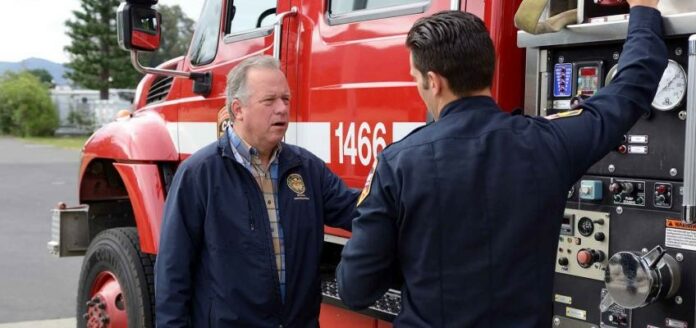FIRE FILE
Late last week, Cal Fire announced that its investigation into four of the wildfires that hit California last year has ended, and that the fires were caused by downed PG&E wires coming into contact with trees. The state agency determined that fires in Butte and Nevada counties—the La Porte fire, the McCourtney Fire, the Lobo Fire and the Honey fire—were all caused by the power lines.
In a statement, Napa State Sen. Bill Dodd (pictured) says, “It confirms what we’ve known all along: that downed power lines can be the source of devastating fires.” Dodd has pending litigation that would compel utility companies to strengthen their infrastructure. “We have an obligation to ensure the utility companies do what’s right to protect Californians.”
No word as yet from Cal Fire on the cause of the Nuns, Tubbs, Adobe and Pocket fires that scorched vast portions of the North Bay last year.
In an extensive release, PG&E defended its vegetation-removal protocols as it highlighted the “new normal” of climate change and its impact on wildfires. The long and short of the PG&E public relations push: “Based on the information we have so far, we believe our overall programs met our state’s high standards.” In March, the investor-owned utility hired Platinum Advisors to lobby on its behalf in Sacramento as bills targeted at PG&E were being introduced by lawmakers, including Dodd. Platinum Advisors was founded by Sonoma County developer and Democratic power broker Darius Anderson.
—Tom Gogola
GRAPE NEWS!
Our local congressional representatives, Mike Thompson and Jared Huffmann, were in Petaluma on Tuesday to drink wine and celebrate the creation of the newest American Viticultural Area—the Petaluma Gap. The AVA designation is sort of a big deal, in that the Petaluma Gap is now an official wine-growing region, joining some 240 others around the country, according to the U.S. government, whose Treasury Department and Bureau of Alcohol, Tobacco and Firearms are the agencies who delineate the bountiful boundaries on behalf of grape-growers. Other AVAs in the region include the Moon Mountain District, Napa Valley and numerous others. It is not known whether the congressmen departed the Tuesday ceremony with a tipsy swagger to their step.—Tom Gogola
LETHAL REJECTION
Jarvis Jay Masters, the Buddhist author and death row inmate on San Quention, has linked up with the American Civil Liberties Union and the organization Witness to Innocence and is suing the state of California over its new lethal injection regulations. Master has maintained his innocence in a capital charge that stemmed from the murder of a corrections guard at San Quentin. In a statement, the Committee to Free Jarvis Masters says the inmate “would like everyone to look at this case in a way that makes it personal—he will be the human being that all these ‘protocols’ will be done to kill him. He wants to make it real and urgent.” Earlier this year, the state unveiled a new single-drug protocol that would use either pentobarbital or thiopental to execute the condemned. —Tom Gogola
GLASS HALF-FULL
“Good evening and welcome folks, I will be your waiter tonight,” I say to my guests as I greet them. “Can I get everyone started with some water?”
“Sure, I’m fine with regular ice water,” says the first patron. “Water is fine for me, too, but can I please have no ice?” another guest asks. “I’d actually like a hot water with lemon,” another chimes in. “And I’d like sparkling water,” requests the final person at the table.
It’s getting hot out there, so from a health perspective, which is best? Is one type or temperature of water better or worse than the others?
There is evidence that different temperatures confer health benefits and drawbacks. Especially during exercise, cool water may be best. A 2013 study published in the International Journal of Clinical and Experimental Medicine found that cool tap water of about 61 degrees Fahrenheit led to less sweating and higher water consumption in the exercising and dehydrated subjects, leading the authors to conclude that this temperature was best at mitigating dehydration.
While drinking ice water may help with weight loss, because the body uses energy to heat this water up to the homeostatic 98.6 degrees Fahrenheit, the effect is quite small. Studies have shown that the body will burn about eight more calories heating up a glass of ice water relative to a glass of room-temp water. Multiplied over, say 8 to 10 glasses a day, this adds up to about 70 calories a day.
Ayurvedic and traditional Chinese medicine practitioners recommend drinking warm to hot water on a regular basis, based on the belief that warm water helps with digestion, whereas cold water leads to sluggish digestion.
Beyond the temperature of water, another bubbling trend right now is sparkling water; industry data shows a major increase in U.S. consumption over the past decade. U.S. sparkling water sales are projected at more than $6 billion by 2021, spurred largely by Americans’ desire for carbonation without the sugar. And guess what? Sparkling water may provide multiple health benefits, according to a 2002 report in the European Journal of Gastroenterology & Hepatology. Regardless of your preference, stay hydrated, people.—Andrew Steingrube











